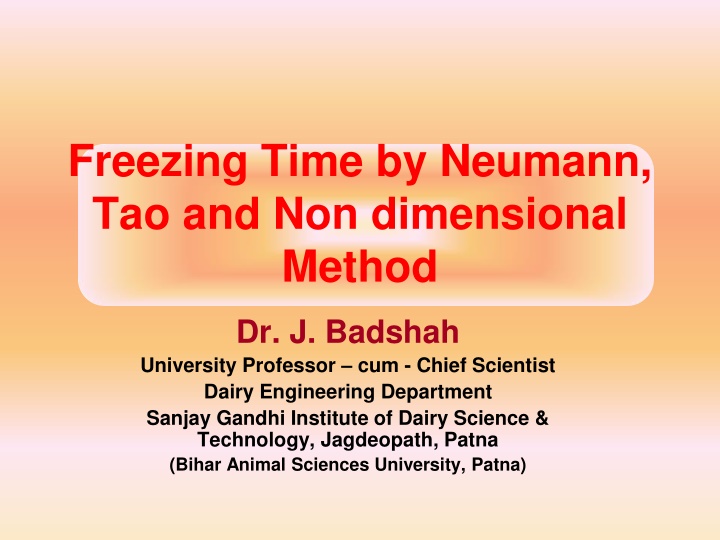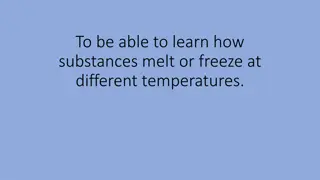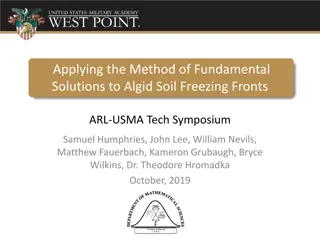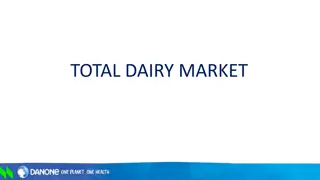Comprehensive Overview of Freezing Time Methods in Dairy Engineering
Neumann, Tao, and Non-Dimensional methods are key approaches for determining freezing times in unsteady state heat transfer processes in dairy engineering. The Neumann Problem, Tao Solutions, and Cleland and Earle Non-Dimensional Equation offer distinct equations and models to calculate freezing times for different geometries and thermal properties. While the Neumann Problem provides a detailed temperature distribution analysis with slight improvements over Plank equation, Tao's charts offer a dimensional approach for infinite shapes. Cleland and Earle introduce a Non-Dimensional Equation based on Fourier Number, Biot Number, and Steffan Number. Each method presents unique advantages and limitations in freezing time computations for dairy applications.
Download Presentation

Please find below an Image/Link to download the presentation.
The content on the website is provided AS IS for your information and personal use only. It may not be sold, licensed, or shared on other websites without obtaining consent from the author.If you encounter any issues during the download, it is possible that the publisher has removed the file from their server.
You are allowed to download the files provided on this website for personal or commercial use, subject to the condition that they are used lawfully. All files are the property of their respective owners.
The content on the website is provided AS IS for your information and personal use only. It may not be sold, licensed, or shared on other websites without obtaining consent from the author.
E N D
Presentation Transcript
Freezing Time by Neumann, Tao and Non dimensional Method Dr. J. Badshah University Professor cum - Chief Scientist Dairy Engineering Department Sanjay Gandhi Institute of Dairy Science & Technology, Jagdeopath, Patna (Bihar Animal Sciences University, Patna)
Neumann Problem for Freezing Time Solution given by Neumann for freezing time determinationin unsteady state heat transfer process for sudden cooling with freezing medium was published in Carslaw and Jaeger (1959). It is well known by Neumann Problem. This approach utilizes one dimensional heat transfer in a semi-infinite body. There are three basic equations which describe the Neumann Problem. The first two are partial differential equations which describe the temperature distribution in the frozen and unfrozen portion of the semi- infinite body in one dimension. These are as follows where subscripts 1 and 2 refers to the frozen and unfrozen portion of the body, respectively: 2T1/ x2= ( 1Cp1/k1) ( T1/ t ) 2T2/ x2= ( 2Cp2/k2) ( T2/ t ) The third equation can be expressed as the difference in heat flux between the solid and liquid portions of a semi-infinite body which must be equal to the heat generated at the freezing front. This can be written as : k1 T1/ x - k2 T2/ x = ( H dx/dt)
Neumann Problem The solution of these equations which describes the temperature distribution in the solid and liquid portions of the semi-infinite body is expressed in error function form. The Neumann problem and the approach used for computation of freezing times represent slight improvement over Plank equation. It is more accurate as it allows two different thermal conductivities and specific heats for unfrozen and frozen portions. The Neumann problem assumes that the latent heat of fusion is removed at constant temperature Tfand does not provide the incorporation of convection heat transfer coefficient into freezing time computation. The application is limited to semi-infinite body geometry only. Due to use of Guass Error function curve/table, in general the procedure for calculation of freezing time is complex. This approach is unlikely to be used when compared to other less complex procedures for calculation of freezing times.
Tao Solutions for Freezing Time Tao (1967) developed charts for infinite slab, infinite cylinder and sphere to determine Freezing times. The dimensionless Numbers shown on these charts are: Dimensionless time tf* = tfkI(TF Tm)/ a2 iL Inverse Biot No. 1/ NBi= kI/ hc. A Modified Steffan No. Nste *= CpI(TF Tm)/ L For each shape the curve is drawn between dimensionless time and Inverse Biot number for different values of modified Steffan Number. Obtaining dimensionless Freezing time tf*, the freezing time can be calculated. L = Latent heat x % water in food, i= Density of Ice kI= Thermal conductivity of ice, a = least dimension NBi= Biot Number, CpI= specific heat of Ice TF= Initial Freezing Temperature Tm= Cooling medium temperature
Cleland and Earle Non Dimensional Equation NFO= P [ 1/ NBiNste] + R [ 1/ Nste] , where NFO = Fourier No. . t /a2 , where t = freezing time and = kI/ iCpI i.e. thermal diffusivity NBi= Biot Number = hc. A / KI Nste= Steffan Number = CpI(TF Tm)/ L By Introducing Plank Number, the influence of Sensible heat above the initial freezing point can be incorporated. NFO= f (NBi , Nste , Npk) Where, Npk= CpI(Ti TF)/ L The empirical expressions were investigated by Cleland and Earle for slab, cylindrical and spherical shapes separately.
Nagaoka et. al. (1955) Equation tf= H / (TF Tm)[P. a /hc+ R a2/ KI], where H = [1 + 0.00445 (Ti TF) ] [Cpu( Ti TF) + L + CpI(TF T)] The modification by Nagaoka has incorporated factors to account for sensible heat above and below the initial freezing temperature. It still assumes that all latent heat is removed at constant temperature TF(i.e. IFT).
Numericals Solve Numerical: compute the temperature at which ice formation begins in an ice cream mix (10 % Fat, 12% SNF, 15 % Sucrose, 0.22 % stabilizer). Assume 25 % of SNF including sugar is bound water) Free water = 100- (10 + 12 + 15 +0.22) 0.25 x (12 +15)= 56.03 Calculate mole fraction of free water xw= (56/ 18)/ [56/18+ 15/342 +4.5/342 +2x1.5/58.5] ln xw= { H/ R} [ 1/ T0 1/ TF] Calculate unknown value from this equation , where R is a gas constant i.e. 1.9872 cal/g. mol. K or 4.8 x 19872 = 8.314 KJ/kg mol. K and H = 80 x 18 = 1440 cal /g mol = 80 x 18 x 4.81= KJ/kg .mol IFT TF= about -3.77 C























